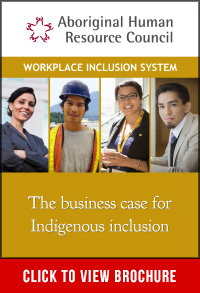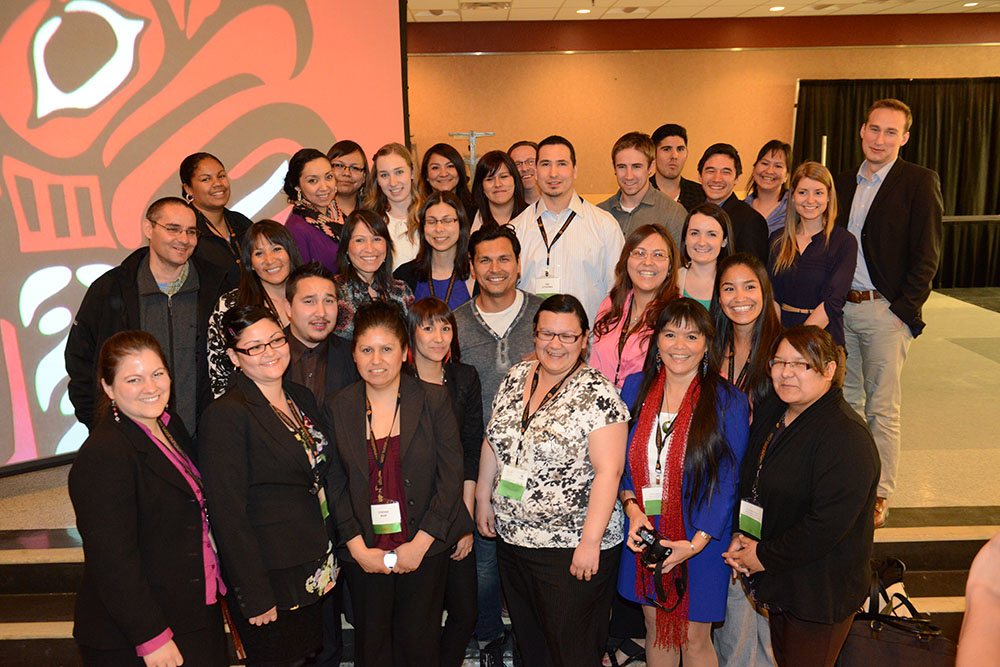The business case for Indigenous inclusion
By Rajitha Sivakumaran
 The lack of both skilled and unskilled labour is a concern across many Canadian industries, but few realize the solution can be found right at home. Canada has its own untapped labour source: our flourishing, young Indigenous communities. There is a real business case for Indigenous inclusion in today’s workforce and the Aboriginal Human Resource Council (AHRC) is working hard to bring that message to Canadian corporations.
The lack of both skilled and unskilled labour is a concern across many Canadian industries, but few realize the solution can be found right at home. Canada has its own untapped labour source: our flourishing, young Indigenous communities. There is a real business case for Indigenous inclusion in today’s workforce and the Aboriginal Human Resource Council (AHRC) is working hard to bring that message to Canadian corporations.
The history of exclusion is being replaced with a new path of inclusion, which is transforming the relationship between Indigenous and non-Indigenous Canadians and creating some of the most powerful social, economic and community changes since the formation of Canada in 1876. The GDP of Indigenous people is $26 billion today and expected to grow to $37 billion over the next decade due to increased employment and partnerships.
About 145 years ago, Aboriginal children were placed in residential schools that were operated by the church and funded by the government. For more than a century, 150,000 children lived isolated from family and culture, and suffered in unspeakable ways. The last of these schools were closed only in 1996 and there are about 80,000 former students still living, many of whom suffer unresolved trauma. It is just one aspect of what Kelly Lendsay, president of the AHRC, calls a painful history.
In response, the Truth and Reconciliation Commission of Canada (TRC) was created both to document the story behind residential schools and promote healing through various calls for action. Of the 94 recommendations it proposed, Lendsay and the AHRC are focused on call to action No. 92, which demonstrates how Canada’s business leaders can promote reconciliation.
The TRC is asking Canada’s corporate sector to adopt the United Nations Declaration on the Rights of Indigenous Peoples, and this includes engaging Indigenous communities before undertaking economic development projects; equal access to jobs and training opportunities for Aboriginal people; and lastly, educate executives and staff about the history of Indigenous people in order to bridge the present knowledge gap. Prime Minister Trudeau has vowed to implement all 94 recommendations and its ‘calls to actions’.
From Lendsay’s experiences working with hundreds of corporations, he knows only too well the difficulties associated with implementing these recommendations. Many Canadian executives are unaware of the business case for Indigenous inclusion. Many companies simply don’t know how to respond to it. Questions that often arise are: Who are the Aboriginal people and what are their aspirations? Why is there a disconnect? Where do I find Aboriginal employees? How do I build relationships and partnerships?
This is where the AHRC comes in. The council was created to craft partnerships between the corporate and Indigenous worlds, promote employment and stimulate economic development opportunities.
“We help non-Indigenous and Indigenous employers build their competencies and strategies, resulting in new and stronger engagements and partnerships between mainstream companies and Indigenous people, companies and communities. For more than 15 years, we have created and tested new models, strategies and practices in collaboration with private, public and Indigenous organizations. Through these partnerships thousands of Indigenous people have become employed and new partnerships have been fostered,” said Stephen Lindley, VP of Aboriginal Affairs at SNC Lavalin.
The Inclusion Continuum, the backbone of the council, is a seven-stage roadmap used by the AHRC to guide companies towards improving their workplace performance and partnership. Directed at management and executives, this program allows both management and staff to become experts at Indigenous inclusion. “There is a real business case for climbing the continuum,” Lendsay said. “Companies like it because it gives them a way to benchmark and measure their progress. It gives them a concrete way to identify strengths and weaknesses and it gives them a way to channel their investments.”
One of the most essential things executives and managers can learn from the AHRC is branding, specifically branding appropriately in order to be seen as a company and workplace of choice for not just Indigenous employment but for Indigenous customers. The council is a bridge facilitating prosperous partnerships that translate into employment, business and corporate social responsibility investments in Aboriginal communities.
Overcoming knowledge gaps and misperceptions
“Employment matters. Both Aboriginal and non-Aboriginal people need a career path. They need to develop their full human resource potential. One problem is the enormous knowledge gap in this country, which gives rise to misperceptions and negative stereotypes,” Lendsay said.
The media is full of negative stereotypes, which do little to propel Lendsay’s vision of prosperity and progress. Historical data spells out statistics that lie in the extreme negative end when it comes to poverty, education, unemployment and health for Aboriginal people. However, according to Lendsay, the past 20 years have witnessed emerging positive trends with more Aboriginal people going into post-secondary education, increased employment and more involvement in entrepreneurship. In fact, the 2006 Census revealed more than 37,000 self-employed Aboriginal people in Canada, up from just over 27,000 in 2001 – an increase of 38 percent. During this time period, the rate of growth for self-employed Aboriginal people was more than five times the seven per cent growth rate of self-employed Canadians overall.
The Aboriginal population is the fastest growing group in Canada; it has grown by 22 per cent in the last five years and 50 per cent of the population is under the age of 25. This baby boom is good news for employers in Canada, for whom labour pressures are one of the greatest challenges presently faced. And just over half of the Indigenous population lives in urban centres.
For companies who need access to resources on or near Indigenous lands, the AHRC facilitates the engagement and partnership readiness of the parties involved to ensure long-term successful and sustainable partnerships. There are positive examples of Indigenous engagement in sectors such as mining and resources where just over 20 per cent of the Indigenous workforce is employed in mining. But the council is targeting disengaged sectors of the economy such as retail, hospitality, clean energy, health and service. The service sector, in particular, is a booming industry in Canada, employing 78 per cent of the country’s workforce. Lendsay believes that the Aboriginal baby boom can be positioned as a workforce solution for this sector.
This year the council is inviting the new sectors to discover the business case for Indigenous inclusion at Inclusion Works 16 (IW16), a management learning forum to be held this November in Banff, Alberta. It is Canada’s premier workplace inclusion leadership gathering. Executives and managers are invited to experience practical solutions and strategies that can be easily implemented in their own companies. It will also be a rich networking opportunity for not just employers but those seeking work; Canada’s only national recruitment fair will also be featured at IW16.
“We have taken a national approach to garner and amplify change that works at the local, regional, provincial and national levels. The council has generated tons of social capital generating new relationships and partnerships. We’ve changed people’s lives,” Lendsay said.
Editor’s Note: In November 2016 the Aboriginal Human Resource Council will be announcing its new name change to “INDIGENOUS WORKS”. Building on its previous work in Indigenous employment and workplace inclusion, the new name heralds the importance of building new partnerships, which improve Indigenous social and economic conditions by improving Indigenous entry to Canada’s mainstream economy.
www.aboriginalhr.ca






